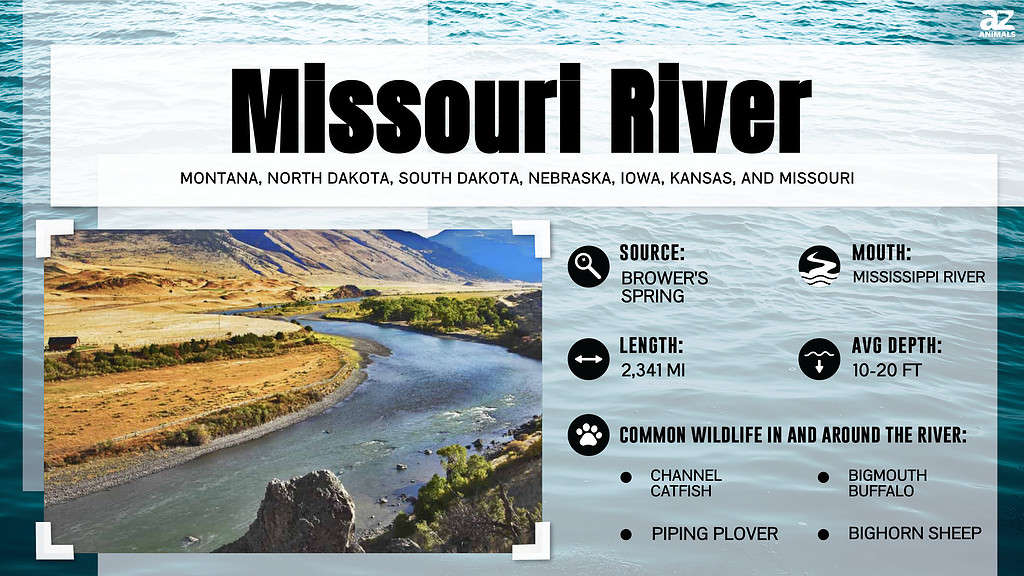The Missouri River is the longest river in the United States and tends to flow quickly throughout much of the year. But it also runs through some states that have incredibly cold winters. So, that leads to the natural question, does the Missouri River freeze in the winter?
It is a good question and one we will explore in the article below. Additionally, this article looks at some basic facts about the Missouri River and what kinds of animals you can expect to find in (or near it).

Does the Missouri River Freeze During Winter?
You may be surprised to learn that, yes, the Missouri River does freeze over in the winter! Well … sort of. Large chunks of ice start forming in the river around Bismark, North Dakota. There is so much ice that the river’s depth increases by 2-6 feet.
Those sheets of ice typically from starting in early December and continue through mid-January. They stay put for approximately 86 days in the winter.
These ice formations also start to work their way down the river. In Missouri, the river regularly flows with what is known as pancake ice during the winter. It gets particularly dense during major cold spells, nearly filling the entire river with floating sheets of ice.
Then in 2021, the river froze over for the first time in mid-Missouri since the 1980s. Since the river completely froze over, the chunks of ice could no longer flow. It created what got nicknamed the Ice Jam of 2021.
But that one paled in comparison to the ice jam that began in December 2022 and continued through January 2023. Many believe it is the worst incident of an ice jam since 1989. This jam is 20 miles long.

The Missouri River freezes over in winter in part. Typically there are solid chunks of ice that float in the coldest months.
©marekuliasz/Shutterstock.com
Did the Missouri River Freeze Historically?
As a matter of fact, the Missouri River used to freeze over much more frequently until recently. Many believe that the river stopped freezing over after work to alter its size and course got completed.
The Corps of Engineers started working in 1929 to narrow the Missouri River. The river we see today is a third the size it used to be. This interference forced the water to move faster and deeper, making it difficult to freeze over often anymore.
Fun Facts About the Missouri River
Everyone likes to talk about the majestic Mississippi River. However, the Missouri River is very impressive in its own right. Here are some fun facts about this under-discussed waterway.
- The Missouri River proper runs for 2,315 miles.
- It starts in Gallatin county, Montana, at about 4,000 feet in elevation.
- The confluence of three separate rivers — Madison, Gallatin, and Jefferson — make up the Missouri River at its headwaters.
- Two historical names for the Missouri River are Peki-tan-oui and Oumessourit.
- The Missouri River’s nickname is “The Big Muddy.”
- It ends where it joins the Mississippi River 10 miles outside of St. Louis.
- The Missouri River formed approximately 30 million years ago.
- Lewis and Clark were the first Europeans to travel the whole river. They did so in 1804.
- Steamboats started getting used on the Missouri River by the American Fur Company in 1830 and reached their heyday in 1858.

The Missouri River provides natural floodplains in many of the states it crosses.
©LanaG/Shutterstock.com
What Animals Live Around the Missouri River?
Wildlife thrives around a reliable water source, which is exactly what the Missouri River offers. Due to its length and the number of states it runs through, no set group of animals inhabits the river or nearby lands. However, it is still fun to get a glimpse of what kinds of animals hang out in or near the Missouri River.
In the Missouri Recreational River area covering South Dakota and Nebraska, visitors may spot twelve reptile species, ten amphibian species, and a collection of small mammals. Additionally, the region is a prime location to watch flocks of birds migrating.
In Montana’s Missouri River Country, one may see slightly greater diversity. Montana is known for its diverse and spectacular collection of wildlife. Some species you may encounter include cormorants, big horn sheep, deer, coyotes, pheasants, bison, elk, eagles, blue herons, osprey, white pelicans, and grouse.

Bison graze near the Missouri River in Montana.
©Scalia Media/Shutterstock.com
The photo featured at the top of this post is © LanaG/Shutterstock.com
FAQs (Frequently Asked Questions)
How deep is the Missouri River at its deepest point?
The estimated depth of the Missouri River can get up to 150 feet. But that is before the river joins with the Mississippi River. At this point, the depth is around 200 feet.
Is the Missouri River drying up?
A drought in the Missouri River basin is currently causing river levels to drop. As of the end of 2022, the drought was still significantly impacting the Missouri River.
Are you allowed to swim in the Missouri River?
Swimming and tubing in the Missouri River are highly discouraged. The river has a relatively fast current that gets up to 7 mph, creating a dangerous situation for anyone in the water.
Thank you for reading! Have some feedback for us? Contact the AZ Animals editorial team.






